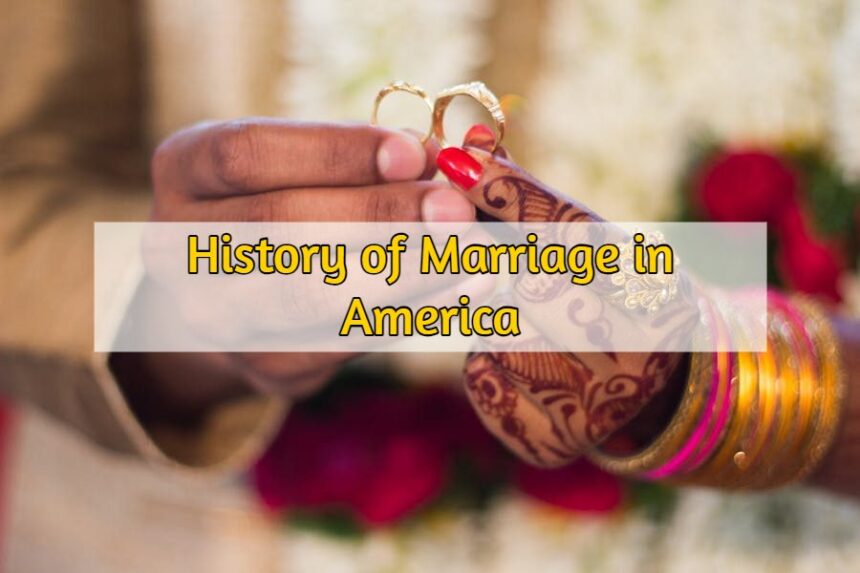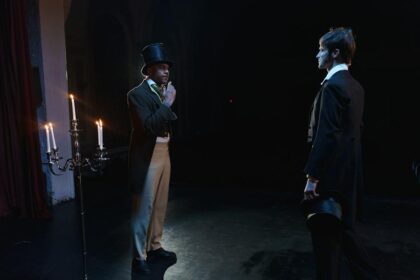The history of marriage in America has evolved from colonial Puritan ideals to today’s diverse customs. It reflects changes in societal norms and legal frameworks.
- Colonial Beginnings And Puritanical Influence
- Love Gains Ground In The 18th Century
- 19th Century Marital Shifts And Women’s Rights
- Industrial Revolution And Shifting Family Dynamics
- Post-war Period: Stability And The Baby Boom
- Modern Era: Redefining Marriage
- Frequently Asked Questions Of History Of Marriage In America
- Conclusion
Marriage in America originated with strict Puritan traditions, heavily influenced by European settlers in the early colonial period. These unions centered around religion and economic stability rather than love. As the nation grew, so did the concept of marriage, adapting to the vast cultural tapestry of America.
The 19th century saw the romanticism of marriage, with love becoming a primary reason for the union. In the 20th century, marriage underwent significant transformations, with laws and attitudes shifting towards gender equality and the recognition of interracial and same-sex marriages. This journey from traditional to modern marriage mirrors America’s broader history—a narrative of constant evolution and striving for individual freedom. American marriages today are boundless in form and function, reflecting the country’s commitment to liberty and personal choice.
Colonial Beginnings And Puritanical Influence
The fabric of early America wove together various customs and beliefs, especially when it came to marriage. Colonial America was a tapestry of cultures, yet the Puritanical influence stood out in shaping societal norms. Exploring the history of marriage during the colonial period unveils how deeply these ideologies rooted themselves in the New World.
Marriage In Early Colonial Times
In the American colonies, marriage was more than a personal bond; it served practical and economic needs. Early colonial marriages were essential for survival. They were alliances meant to secure land, wealth, and social status for the parties involved.
- Legal Bonds: Marriage contracts often stipulated property rights and inheritance.
- Community Involvement: Communities took part in ensuring the stability of these unions.
Religious leaders also played a critical role in officiating and recording marriages, further emphasizing their societal importance.
Puritan Views On Matrimony
The Puritans held a distinct perspective on the institution of marriage, considering it a holy covenant. They believed marriages should reflect spiritual and moral principles.
| Puritan Tenet | Implication for Marriage |
|---|---|
| Mutual Love | Marriage was seen as a partnership based on love and affection, rather than just convenience or arrangement. |
| Community Oversight | The community ensured that the marriage served not only the couple but also the common good. |
Importantly, the Puritans also instituted marriage as a publicly conducted ceremony, reinforcing the communal aspect of matrimonial unions.
Love Gains Ground In The 18th Century
As America found its footing in the 18th century, love began to weave its way into the fabric of marriage. The age showed a shift from arranged unions to those based on mutual affection. Let’s explore the notable changes in the perspectives on love and choice that started to emerge.
Emerging Concepts Of Love And Choice
In this era, the idea of marrying for love was a fresh breeze. People started to see marriage as more than just economic or social agreements. Young hearts now dreamed of companionship and passion, encouraged by social changes and enlightenment thinking.
- Literature and philosophy celebrated love as essential for marriage.
- Couples began to have a say in choosing their partners.
- Personal happiness started to take center stage in romantic ties.
Societal Transformation Of Romantic Relationships
The 18th century saw dramatic changes in how society viewed romantic relationships. Marriage for love slowly became a cultural ideal, changing expectations for lifelong partnerships.
| Before | 18th Century |
|---|---|
| Arranged Matches | Love-based Matches |
| Economic Alliances | Emotional Bonds |
| Parental Decisions | Individual Choice |
Courting started to be based on personal interaction, rather than family negotiations. Women’s opinions in the choice of a spouse took on new importance. Love was being carved as a cornerstone of American marriages, setting footprints for the future.
19th Century Marital Shifts And Women’s Rights
The 19th century marked a pivotal point for marriage in America, witnessing significant shifts and strides in the realm of women’s rights. During this era, societal perceptions of marriage underwent revolutionary changes, paralleled by a growing call for gender equality. This period paved the way for crucial developments that redefined the institution of marriage.
Legal Changes In Marriage
Legal reforms in the 19th century transformed marriage. States started to enact laws granting married women property rights and legal identities separate from their husbands. Let’s uncover some key legal changes:
- Married Women’s Property Acts: Various states passed these acts allowing women to own property, sign contracts, and inherit estates.
- Consent laws: These raised the age at which individuals could marry and emphasized the importance of mutual consent.
- Divorce legislation: Divorces became more accessible, moving away from the previously stringent conditions required for dissolution.
Rise Of The Women’s Suffrage Movement
As legal transformations unfolded, the women’s suffrage movement gained momentum. Advocates for women’s voting rights linked marriage reforms to broader themes of democracy and individual autonomy.
Activists like Elizabeth Cady Stanton and Susan B. Anthony became prominent voices. They argued for women’s full participation in society including the right to vote.
| Year | Event |
|---|---|
| 1848 | Seneca Falls Convention, the first women’s rights gathering |
| Late 1800s | Formation of groups like the National American Woman Suffrage Association (NAWSA) |
The suffrage movement, intertwined with marital reforms, ushered in an era of social transformation. It forever changed the political landscape in America.
Industrial Revolution And Shifting Family Dynamics
The Industrial Revolution brought sweeping changes across America. It not only revolutionized industry but also transformed how families functioned. As factories emerged and cities grew, marriage and household structures adapted to new economic realities.
Economic Factors Impacting Marriage
The quest for financial stability became crucial for marital unions. Jobs shifted from farms to factories. This change altered what families needed to thrive. Men, the traditional breadwinners, now sought work outside the home. This shift created a financial dynamic where marriage was often as much about economic necessity as it was about love.
Urbanization And The Middle-class Family Ideal
Urban growth led to the rise of the middle-class family ideal. This new ideal included a working father, a home-making mother, and children attending school. These changes reflected the nation’s new economic structure. People married to create a stable home to navigate city life and to rear educated children geared for the new workforce.
- Emergence of the nuclear family: Fewer extended family members shared the home, making the nuclear unit prominent.
- Rising importance of education: Parents aimed to equip children with skills for industrial jobs.
Post-war Period: Stability And The Baby Boom
As World War II ended, America entered an era of unprecedented stability and growth. Soldiers returned home, eager to start families and build lives during a time of newfound peace. The post-war period saw the rise of the Baby Boom, a phenomenon where birth rates soared as optimism flooded the nation. Young couples married quickly and started families, marking the beginning of what came to be known as the golden age of the American family.
The 1950s Nuclear Family
The 1950s brought the ideal of the nuclear family – a married couple with children – to the forefront. Popular culture and media glorified this family structure, often depicting a working father, a homemaking mother, and their cheerful children. Television shows like “Leave It to Beaver” painted a picture of domestic bliss that many Americans strove to emulate. This representation set a powerful standard, influencing the aspirations of countless families across the country.
Cultural Norms And Marriage Expectations
Cultural norms of the time heavily prescribed marriage as a necessity for adult life. It wasn’t just a personal commitment but a societal expectation. By marrying, one fulfilled their civic duty, contributing to the country’s moral fabric and economic prosperity. The average age for marriage was in the early twenties, much younger than in previous decades. Notably, marriage was so ingrained in post-war culture that remaining single past a certain age often invited social scrutiny.
- Men were expected to be breadwinners, securing financial stability.
- Women generally took on the role of homemakers, managing household duties and raising children.
- Having a large family was not just common but encouraged, linking directly to the Baby Boom.
- Divorce rates were low, as marital permanence was a key value.
Modern Era: Redefining Marriage
The modern era has witnessed transformative changes in the concept of marriage in America.
These changes reflect the nation’s evolving social values and legal principles.
Marriage redefinition has become a significant topic.
It now includes broader forms of partnership and rights once denied.
Same-sex Marriage Legalization
The journey to legalize same-sex marriage has been a historic evolution.
It represents a profound shift in American ideals of equality and justice.
In 2015, the landmark Supreme Court decision in Obergefell v. Hodges granted same-sex couples the right to marry. This momentous ruling was celebrated across the nation.
- Obergefell v. Hodges: A Supreme Court case that changed marriage laws.
- 2015: The year when same-sex marriage became legal nationwide.
- Equality: All couples gained equal marriage rights.
Changing Social Attitudes
Social attitudes toward marriage have undergone a significant transition.
Support for diverse forms of marriage has grown.
This shift can be seen across demographics and is often discussed in media and politics.
Polls and surveys indicate a steady increase in acceptance.
Many Americans now view various forms of marriage as valid expressions of love.
| Year | Support Level |
|---|---|
| Early 2000s | Low acceptance |
| 2010s | Rising support |
| 2020s | High acceptance |
Frequently Asked Questions Of History Of Marriage In America
When Did Marriage Become A Thing In America?
Marriage in America traces back to colonial times, becoming formalized with laws in the 1600s. Colonial marriages often combined legal, social, and religious practices.
What Is The Historical Background Of Marriage?
The historical background of marriage traces back to ancient times, primarily for alliances and property exchange. Originating over 4,300 years ago, it has evolved through cultural and religious practices, shaping societal norms and personal relationships globally.
What Was Marriage Like In The 1800s In America?
Marriage in the 1800s America typically involved traditional gender roles, with unions often arranged for economic or social benefits. Love gradually became a more common marriage foundation towards the century’s end.
When Did Marriage Licenses Start In America?
Marriage licenses began in America in the late 17th century. Massachusetts started the practice in 1639.
Conclusion
The journey through America’s marital past offers a window into societal evolution. As customs and laws adapted, the concept of marriage expanded. Recognizing diverse traditions and legal milestones enriches our understanding of this enduring institution. Embracing history’s lessons, we pave the way for future matrimonial progress.




